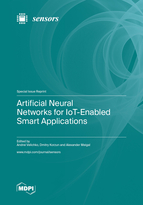Artificial Neural Networks for IoT-Enabled Smart Applications
A special issue of Sensors (ISSN 1424-8220). This special issue belongs to the section "Internet of Things".
Deadline for manuscript submissions: closed (15 April 2023) | Viewed by 38802
Special Issue Editors
Interests: neural networks; entropy, constrained devices; IoT; reservoir computing; ambient intelligence; synchronization of coupled oscillators; switching effect; smart sensors
Special Issues, Collections and Topics in MDPI journals
Interests: ambient intelligence; smart spaces; internet of things; networking; mathematical modeling; performance evaluation; data mining; information services; industrial internet; socio-cyber-physical systems; software engineering
Special Issues, Collections and Topics in MDPI journals
Interests: nonlinear dynamics of biosignals; motion analysis; extremal environments; microgravity; ageing; parkinsonism; ambient intelligence; smart spaces; Internet of Things; socio-cyberphysical systems
Special Issues, Collections and Topics in MDPI journals
Special Issue Information
Dear Colleagues,
In the age of neural networks and the Internet of Things (IoT), the search for new neural network architectures capable of operating on devices with limited computing power and small memory size is becoming an urgent agenda. Various artificial intelligence (AI) applications in the IoT field include smart healthcare services, smart agriculture, smart environment monitoring, smart exploration, and smart disaster rescue. Traditionally, such applications operate in real time. For example, security camera-based object-recognition tasks operate with detection intervals of 500 ms to capture and respond to target events. Data processing of human health and physiological parameters from different sensors (heartrate monitoring, glucose monitoring, oxygen saturation, etc.) generally requires immediate processing. Often, commercial smart IoT devices transfer information to the cloud for subsequent intelligent processing. However, stable network connections are not available everywhere, which is a limitation for meeting real-time requirements. The solution to this problem can be the execution of information processing using neural networks installed directly on IoT devices. In this case, the quality of the Internet connection would not have a significant impact. Enabling artificial intelligence directly on the device is difficult due to the limited computing power and small memory size of IoT devices. Frequently, smart applications need to run on a lightweight OS with a minimal set of libraries, which imposes limitations on the operation of resource-intensive neural networks.
AI technologies for IoT devices and edge computing are demanded in mobile healthcare (m-Health), as well as in close application domains. Ambient intelligence (AmI) environments are constructed in IoT environments to provide smart services for people based on real-time analysis of human cognitive and motion functions. Examples include but are not limited to:
- At-home labs for people to make medical observations and analysis during everyday life, not in specific and limited conditions of a professional medical lab at hospital;
- Applications for Industrial Internet when real-time monitoring of human movement and health parameters supports detection of dangerous situations and incorrect activity in technological operation;
- Tactile Internet with its demand in bionic applications when a person can “touch and perceive” distant physical objects or even virtual (digital) objects through the Internet.
This Special Issue is dedicated to recent developments in the constantly growing application field of computing technologies and artificial intelligence algorithms and includes new approaches to the organization of artificial intelligence on peripheral devices, organization of modular, feed forward, distributed, reservoir, recurrent, convolutional and deep neural networks for various IoT-enabled smart applications.
Dr. Andrei Velichko
Prof. Dr. Dmitry Korzun
Dr. Alexander Meigal
Guest Editors
Manuscript Submission Information
Manuscripts should be submitted online at www.mdpi.com by registering and logging in to this website. Once you are registered, click here to go to the submission form. Manuscripts can be submitted until the deadline. All submissions that pass pre-check are peer-reviewed. Accepted papers will be published continuously in the journal (as soon as accepted) and will be listed together on the special issue website. Research articles, review articles as well as short communications are invited. For planned papers, a title and short abstract (about 100 words) can be sent to the Editorial Office for announcement on this website.
Submitted manuscripts should not have been published previously, nor be under consideration for publication elsewhere (except conference proceedings papers). All manuscripts are thoroughly refereed through a single-blind peer-review process. A guide for authors and other relevant information for submission of manuscripts is available on the Instructions for Authors page. Sensors is an international peer-reviewed open access semimonthly journal published by MDPI.
Please visit the Instructions for Authors page before submitting a manuscript. The Article Processing Charge (APC) for publication in this open access journal is 2600 CHF (Swiss Francs). Submitted papers should be well formatted and use good English. Authors may use MDPI's English editing service prior to publication or during author revisions.
Keywords
- IoT environment
- Internet of Medical Devices
- healthcare-monitoring devices
- IoT-based healthcare services
- smart IoT-based agriculture
- smart IoT-based environment monitoring
- smart IoT-based exploration
- smart IoT-based disaster rescue
- edge computing
- mobile computing
- constrained devices
- deep neural network
- distributed neural networks
- feed forward neural network
- convolutional neural network
- recurrent neural network
- reservoir neural network
- modular neural network









